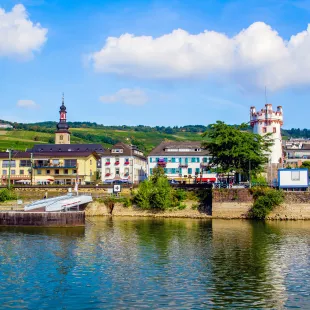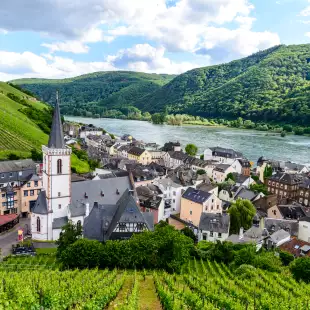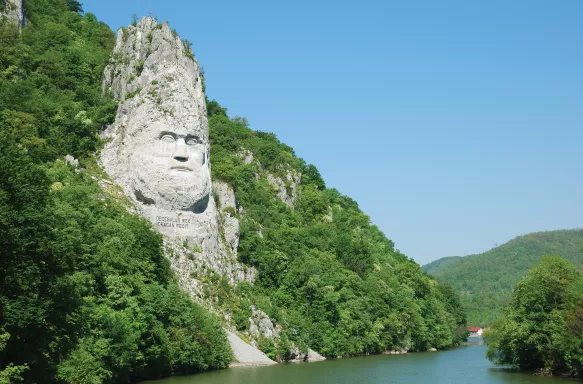A Map of the Danube: From Black Forest to Black Sea

The Danube river passes through 10 countries and breathtaking landscapes all the way to the Black Sea. Soak up all that Europe’s most cultured river has to offer in five capital cities – Vienna, Bratislava, Budapest, Belgrade and Bucharest – and other sites of historical and cultural significance on a cruise on the Danube.
Want to know the best places to see along the Danube river? Check out our map of the Danube and find out more about our favourite places to visit.

Places To Visit On The Danube River:
The Black Forest
The Danube forms on the Western slopes of the Black Forest in southwest Germany. It starts life at the confluence of two streams – Brigach and Brreg, near Donaueschingen – and meanders through the heart of Central Europe before reaching the Black Sea.
Sail through the rugged landscape of the Black Forest Mountains on a Rhine Cruise to Switzerland.

Linz
Located directly on the Danube, Linz became an important centre for medieval trade.
Once a centre of industry, Linz has become a leader when it comes to art, culture and technology. You can experience the city’s unique combination at one of the many museums and discover why Linz is designated as a UNESCO City of Media Arts. Among the many museums in Linz is the Castle Museum, housing a fine collection of1919th and 2020th-century artworks in the 17th-century castle built by Rudolf II.
As you explore the streets of Linz, you’ll stumble upon many historical sites, including the charming Baroque Old Town and the seat of the Upper Austrian Provincial Government, housed in the Monastery of the Friars Minor. At the heart of the city lies one of the largest urban squares in Europe and one of the finest. The square is lined with grand pastel-coloured facades with the impressive Trinity Column of white marble at the centre.
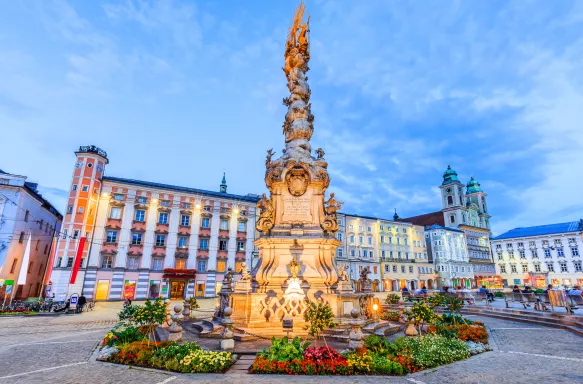
Salzburg
While not directly on the Danube, Salzburg is easily accessible from the river and a fascinating city to explore.
Designated a UNESCO World Heritage site for its ‘outstanding value to humanity’, Salzburg has retained its rich urban fabric, developed from the middle ages to the 19th century when it was a city-state ruled by a prince-archbishop.
Known as the ‘Rome of the North’, Salzburg was ruled by a prince-archbishop who was permitted to appoint his own bishops, as the Pope did elsewhere. Until 1806, he ruled over the largest ecclesiastical state in the world. Only Rome was bigger. The sacred and secular buildings from across the centuries have been well preserved, so there are many historical sites to see during your visit.
The Old Town is full of museums and exhibitions on Salzburg’s favourite son, Wolfgang Amadeus Mozart. Explore the house where he was born, visit the Mozarteum Foundation, visit the resting place of his father Leopold and his widow Constance in the cemetery of St. Sebastien and see the Mozart Monument.

Melk & Benedictine Abbey
Once a Roman fort overlooking the Danube at the start of the Wachau Valley, Melk developed into a picturesque town known for the enormous honey-coloured Abbey. Originally built as a castle, it was gifted to the Benedictine Order in the 11th century remaining a monastic school and monastery despite being reconstructed in the Baroque style you see today. Melk Abbey is renowned for its portrait-lined 214-yard-long Emperor’s Gallery, grande rooms and ornate library boasting around eighty thousand manuscripts. The church here houses some great works of art by Baroque masters, and the manicured gardens are ripe for exploration.
Enjoy a break after exploring the Abbey in the quaint town below, full of narrow streets lined with inviting cafes, shops and restaurants.

Spend the morning exploring this extraordinary building on our Cruise the Heart of Europe river cruise, with additional stops along the Danube in Vienna, Bratislava and Budapest.
Dürnstein
This tiny town clings to the north bank of the Danube River in Lower Austria. Known for the cool-blue tower of the Abbey, which is easily spotted from the riverside, and the castle where Richard the Lionheart was held captive by Duke Leopold V of Austria. While the medieval castle now lies in ruins, it’s still worth a visit with panoramic views of the town and river below and a lovely path through the vineyard.
Located in the middle of the Wachau Wine region, Dürnstein is known for its wineries; you’re likely to see a vineyard in whichever direction you look. Don’t miss an opportunity to sample the region’s finest wines at a local wine cellar. We recommend the regional Rieslings, which are celebrated for their high quality.
Apricots are also grown in the Wachau region; Dürnstein’s apricot dumplings, strudel and brandy are all local delicacies to try while you’re there.

Vienna & Schönbrunn Palace
Vienna
Austria‘s capital lies to the east of the country on the banks of the Danube. With a blend of imperial traditions, music and charm, the city’s very name provokes images of elegance. Once the cultural centre of Europe, the Baroque architecture and magnificent buildings that Vienna is famous for reflect the city’s imperial status.
The skyline in the heart of the city is dominated by the multi-coloured roof and Gothic South Tower of St. Stephen’s Cathedral, a must-see for visitors. As does the former principal imperial palace of the Habsburg dynasty, the Hofburg.
On a visit to one of the biggest palace complexes in the world, you can marvel at the lavish private apartments and staterooms of the former imperial family, wander around the Sisi Museum and examine the expansive silverware collection. The Hofburg also hosts the Spanish Riding School, home to the Lipizzaner stallions, which you can see in action at regular training sessions, mini-shows or formal performances (booking ahead is necessary for these performances).

Schönbrunn Palace
Schönbrunn Palace is a lasting symbol of the power and influence of the House of Habsburg from the 17th to the early 20th century. Once the summer residence of the Austrian imperial family, the growth of the city now means Schönbrunn is an oasis amid 21st-century Vienna. Here you can tour 40 of the most spectacular rooms, following the footsteps of the Habsburg Emperors and Empresses and other historical figures, such as Napolean and Mozart.
There are several museums on the estate, including a collection of carriages, sedan chairs and other modes of transport used by the imperial family and a children’s museum with exhibitions about the lives of the imperial children.
The Palace and Gardens of Schönbrunn are protected as a UNESCO World Heritage site as an outstanding example of the most impressive and well-preserved Baroque ensembles of its kind in Europe. The gardens combine the glory of the Habsburg house with a homage to nature, with over a square kilometre of tree-lined paths, lawns, woods, and landscaped flower beds. Dotted throughout the gardens are various architectural delights such as fountains, follies, statues and walled gardens, and the Orangery to the east of the main palace is the longest in the world at 186m.
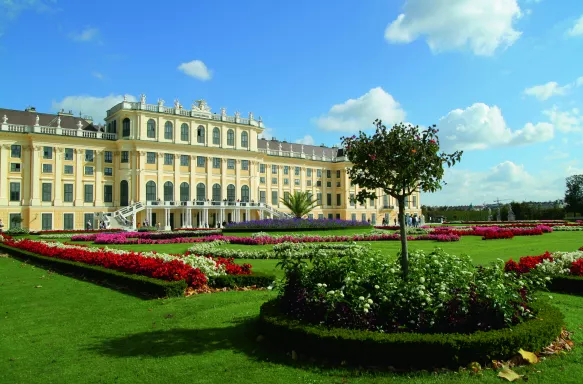
Bratislava
Bratislava straddles the Danube river, sitting on both sides of the river in the southwest corner of Slovakia. After the uniformity of Communism, this capital city is fast rekindling the splendour of its imperial past. Bratislava hosts a blend of architecture, from medieval and Gothic Old Town, Baroque palaces and a castle restored to its Renaissance finery.
This small historical city is perfect for shopping, dining and enjoying the natural wonders. In the Old Town, you’ll find the hilltop castle and the tall spires of St. Martin’s Cathedral among a maze of cobblestone streets. Throughout Old Town, there are small parks decorated with fountains and an abundance of cafes and restaurants. Stop in and sample local dishes like the Slovakian national dish: Bryndzové halušky (little potato dumplings smothered in sheep’s cheese and topped with bacon bits).
As a centre of clockmakers in the old Austro-Hungarian Empire, the Museum of Clocks, in the former Jewish quarter, displays an impressive collection from the 17th to the end of the 19th century. There are several other museums in the city to explore, including two in Bratislava Castle: the Slovak Historical Museum, which displays historical artefacts and antiques and the Music Museum, with local folk instruments scores and recordings.

Esztergom
Esztergom was the country’s first capital city and the birthplace of its first king, St. Stephen I, who made it the centre of the Catholic church in Hungary. Since then, the town has become an ecclesiastic and tourist centre.
Towering over the city is one of the city’s most famous landmarks, the Esztergom Basilica. This neoclassical cathedral boasts one of the world’s largest altarpieces and a wealth of other priceless religious artefacts.
Close to the banks of the Danube river, high on a hill, sits the remains of Esztergom Castle. The site was the former Royal Palace, built by French architects in the 12th century during Esztergom’s golden age. Now The Castle Museum, today’s structure is a mix of modern brickwork and medieval stone masonry. The exhibitions there tell the story of the Castle of Esztergom through its extensive collection of pottery, coins, weapons and ancient stonework.

Budapest
The twin cities of Buda and Pest sit on either side of the Danube river on a geological fault line, where the Buda hills meet the Great Plain. Here, the legacy of Ottoman rule lives on in the thermal Hamman-style baths, such as Rudas Baths and Veli Beji Baths, which date back to the 16th century. After Ottoman rule, Budapest became an imperial city of the Habsburg Empire, attracting great wealth and resulting in an abundance of important landmarks, which earned the city its UNESCO World Heritage Site status in 1987.
The Buda Castle District is one of the most beautiful and romantic areas, housing many of our favourite sights. The Royal Palace, or Buda Castle, remains one of the main symbols of Budapest, dominating the city from the top of Várhegy hill. Beneath the palace is the Labyrinth, used throughout history as a shelter, a prison, a hospital and even a Turkish Harem. For the best photographs of the city, the Fisherman’s Bastion, built as a decorative fortification in the 19th century, offers fantastic views of the city and the river below. Close by is Matthias Church, used as the coronation church for Hungarian rulers for centuries.
As the second largest city on the Danube, Budapest’s visitors are never stuck for things to do with endless galleries, museums, architecture and shopping.

We visit Linz, Salzberg, Melk, Durstein, Vienna, Bratislava, Esztergom and Budapest on The Blue Danube river cruise.
View all river cruises in Hungary
Belgrade
The Serbian capital is the only European capital to sit at the confluence of two rivers, Belgrade is another must-see city along the Danube.
The city is home to a variety of architectural styles reflecting its long history dating back to 400 BC. Belgrade was fought over numerous times, expanded by the Romans and besieged over a hundred times during its history. We recommend exploring the compact city on foot, as remnants of Belgrade’s troubled past are visible throughout the city’s infrastructure.
For those who enjoy science, a visit to the Nikola Tesla Museum is a must. Dedicated to Belgrade’s most famous son, the museum is a great way to explore science history while honouring one of the region’s most important figures.
Outside of the city centre is a little oasis for rest, recreation and entertainment, Ada Ciganlija. The perfect place to cool down during the warm Serbian summer, the peninsula is rich with forests and wildlife and its own specific microclimate. Nicknamed ‘Belgrade’s Seaside’, thousands of citizens and tourists in the know come here to swim, sunbathe and enjoy a great atmosphere, good music and watersports.
There are also many other historical sites to visit; wander the lattice of winding streets in Old Town, see the church of Saint Sava, Republic Square and Prince Michael Street with a wealth of 19th-century buildings with intricate Habsburg ornamentation, some bearing scars of the recent conflicts.

Iron Gates Gorge
Between Serbia and Romania is the Iron Gate of the Danube River. Once a treacherous stretch of the river, the government built a massive lock and dam to help control the speed. As a result, the water rose 130 feet, changing the geography and washing away whole communities.
Sailing through the Iron Gates boasts spectacular scenery of massive cliff faces and narrow gorges. On the Romanian side of the river, carved into the rock is the face of Decebalus, the world’s largest rock sculpture on a river bank.
Bucharest
Romania’s capital and largest city is nicknamed ‘Little Paris’ for its elegant french-style villas and tree-lined boulevards. Dominating the capital is the Palace of the Parliament, a vast concrete building commissioned by the Communist dictator Nicolae Ceausescu. Started in 1984 and still unfinished, it’s the second-largest administrative building in the world, beaten only by the Pentagon, USA.
The city’s other main sites include the former Royal Palace, built by King Carol I after Romania was proclaimed a Kingdom in 1881. Now the National Art Museum, it holds collections of medieval and modern Romanian art and international art pieces collected by the royal families of Romania.

Constanta
The seaport of Constanta can trace its history back more than 2,500 years. Legend has it Constanta was visited by Jason and the Argonauts after finding the Golden Fleece. Constanta flourished during the 13th century when Genoese merchants dominated the Black Sea but the city fell into decline under Turkish rule, two centuries later. Now an important cultural and economic centre for Romania, Constanta is worth visiting for the Old Town’s architecture, its historical monuments and ancient ruins.
While most visitors pass through Constanta on their way to beach resorts in the summer, there’s plenty to see and do.
The casino here has been a landmark in Constanta for over 130 years. Built in 1910 with a billiard room, buffet and other facilities, the casino fell into disrepair during WWI and WW2 and turned into a Soviet-style Palace of culture. Abandoned since 1989, renovations have begun to restore the building to its former glory and with stunning seaside vistas, it’s a great place to take photos.
There are several museums throughout the city, including the Naval History Museum, the Natural Sciences Museum complex and the National History and Archeological Museum.
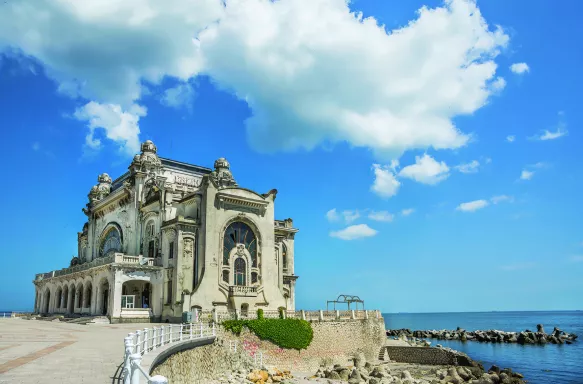
Danube Delta & Black Sea
The river runs for roughly 2850km, or around 1770 miles, flowing through 10 countries until it reaches the Black Sea via the Danube delta, which covers an area of 1660 square miles and continues to grow towards the sea at a rate of 24 to 30 metres per year.
The Danube Delta is a protected UNESCO World Heritage site, forming the largest and best-preserved delta in Europe. The delta is home to a variety of wildlife, including over 300 species of birds and 45 freshwater fish species in its numerous lakes and marshes.
Flowing to its end, the Danube river reaches the Black Sea. The lower levels of the Black Sea are inhospitable to most sea life due to weak ventilation, making it almost biologically dead. However, the upper levels are home to 180 species of fish, such as sprat and horse mackerel and other sea life, including the spiny dogfish (a small shark).

We visit Budapest, Belgrade, the Daube Delta and Constana and so much more along the Danube River on our Budapest to The Black Sea river cruise.





